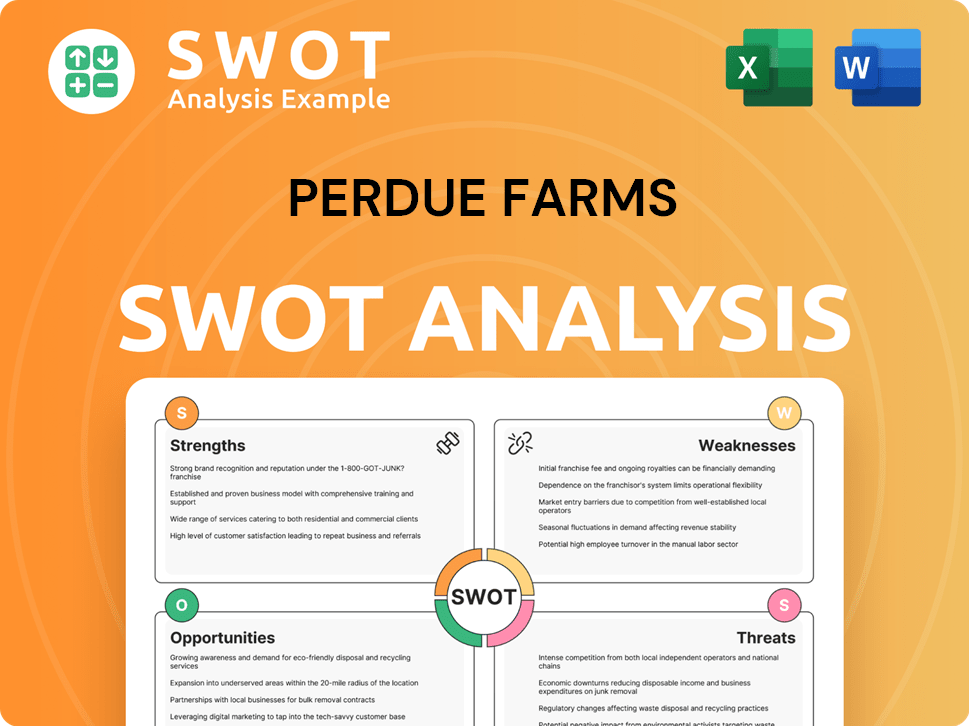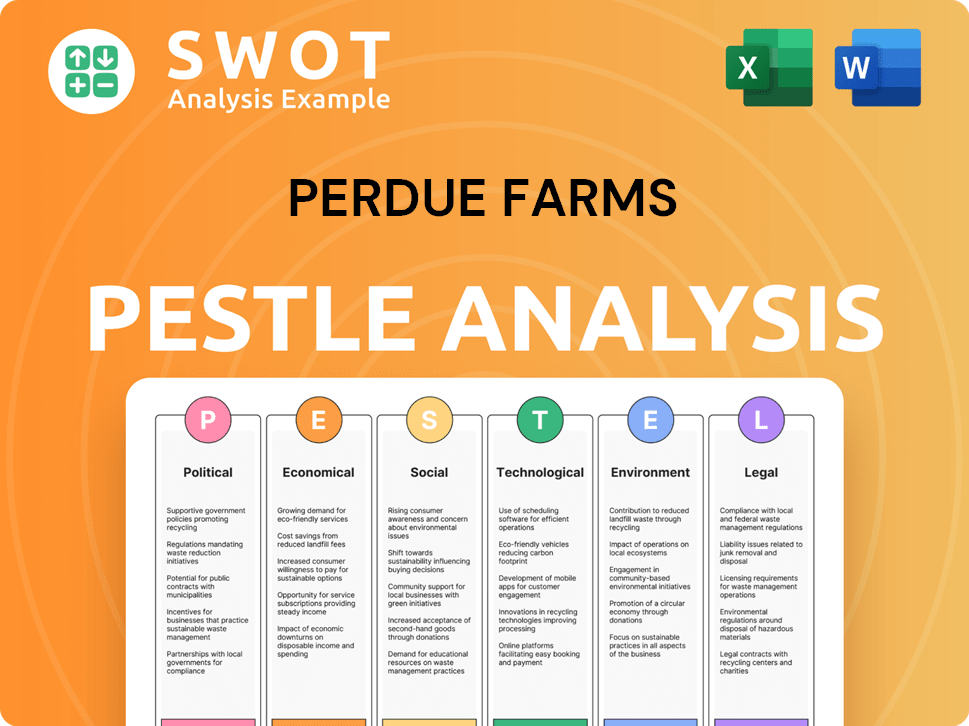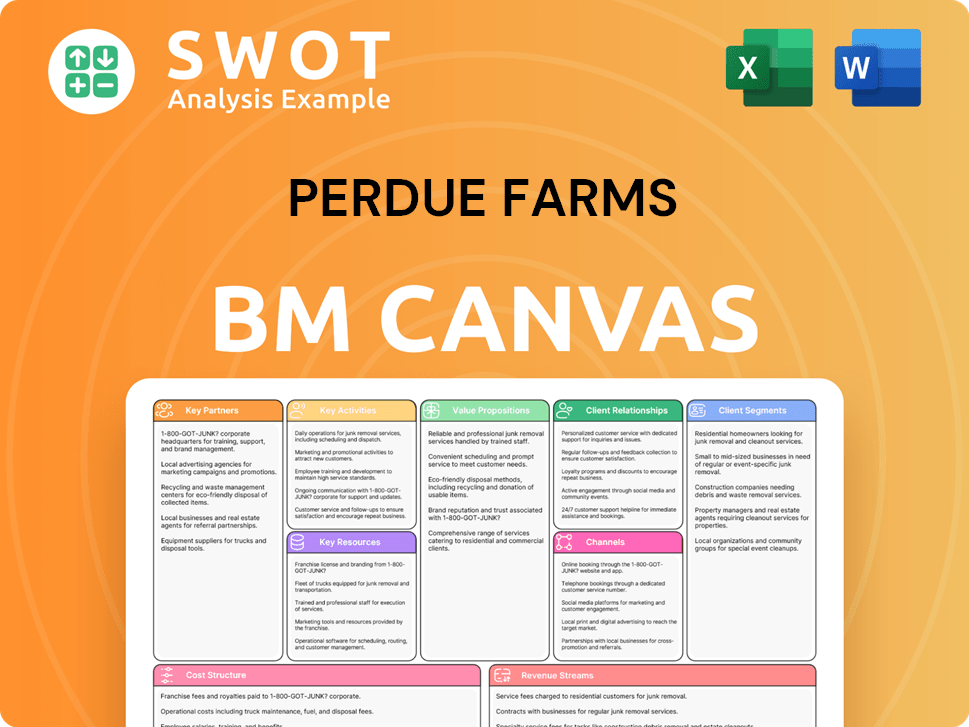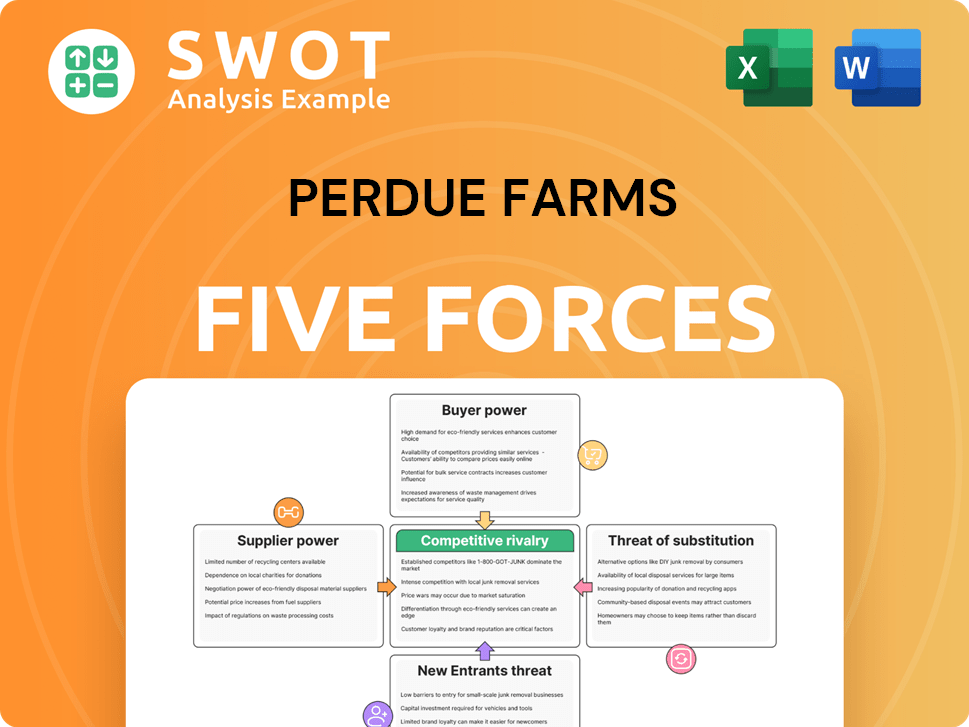Perdue Farms Bundle
How Does Perdue Farms Stack Up in Today's Poultry Arena?
From a humble egg farm to a multi-billion dollar food giant, Perdue Farms has carved a significant niche in the U.S. food and agriculture sector. Founded over a century ago, the company's journey reflects a relentless pursuit of quality and strategic adaptation. But how does this iconic brand fare in the cutthroat world of meat processing?

This analysis delves into the Perdue Farms SWOT Analysis, examining its position within the poultry industry, and the chicken market. We'll dissect the Perdue Farms competitive landscape, identifying its main Perdue Farms competitors and providing a detailed Perdue Farms market analysis. Furthermore, we will explore the company's Perdue Farms market share analysis, its business strategy, and its industry position to understand its strengths, weaknesses, opportunities, and threats in comparison to other meat processing companies.
Where Does Perdue Farms’ Stand in the Current Market?
Perdue Farms holds a prominent position within the U.S. poultry industry, recognized as one of the largest providers. The company's operations encompass poultry (chicken and turkey), pork, and grain-based food products. Its diverse product portfolio includes brands like PERDUE®, Niman Ranch®, and Coleman Natural®, catering to retail, foodservice, and direct-to-consumer channels.
The company's value proposition centers on providing high-quality protein products, emphasizing both conventional and premium offerings. Perdue AgriBusiness, a division, plays a significant role in agricultural product merchandising, processing, and exporting, including the manufacturing of specialty oils and organic feed ingredients.
Perdue's chicken sales reached $4.95 billion in 2024, with overall poultry sales at $5.372 billion. In 2024, the company produced 63.75 million pounds of ready-to-cook chicken. The company reported annual sales in excess of $10 billion in 2024, demonstrating its substantial market presence within the chicken market.
Perdue's product mix in 2024 was predominantly fresh at 79%, with 21% frozen. Sales channels are primarily retail (65%), followed by wholesale (17%), foodservice (15%), and export (3%). The company offers a range of products, including chicken, turkey, pork, and grain-based food products, through various channels.
Perdue has evolved from selling eggs to breeding chicks and then to directly selling processed meat. It was an early adopter of consumer trends, focusing on reducing animal cruelty and offering organic, antibiotic-free product lines. The company's focus on innovation and consumer preferences has shaped its business strategy.
Perdue's financial performance is marked by substantial revenue figures, with annual sales exceeding $10 billion in 2024. The company has shown growth in its employee count, reaching a workforce of 8,886 employees, with significant revenue per employee at $378,000. This indicates a strong operational efficiency.
Perdue Farms' competitive advantages include its large market share, diversified product offerings, and integrated operations. The company's early adoption of consumer trends, such as organic and antibiotic-free products, has also provided a strategic edge.
- Strong market position within the poultry industry.
- Diversified product portfolio, including poultry, pork, and grain-based products.
- Focus on consumer trends and sustainability initiatives.
- Vertical integration and quality control.
Perdue Farms SWOT Analysis
- Complete SWOT Breakdown
- Fully Customizable
- Editable in Excel & Word
- Professional Formatting
- Investor-Ready Format

Who Are the Main Competitors Challenging Perdue Farms?
The competitive landscape for Owners & Shareholders of Perdue Farms is dynamic, shaped by a mix of direct and indirect rivals. The poultry industry is highly competitive, with companies constantly vying for market share and consumer preference. Understanding the key players and their strategies is crucial for assessing the company's position and future prospects.
The company faces competition from both established poultry producers and emerging players in the food industry. These competitors employ various strategies, including product innovation, cost management, and sustainability initiatives, to gain an edge. Market analysis of these competitors reveals insights into the challenges and opportunities within the sector.
The company's main rivals include both large, diversified food corporations and smaller, specialized producers. These competitors vary in size, product offerings, and geographical presence, creating a complex competitive environment. The company's ability to adapt and innovate is critical for maintaining its competitive advantage.
The primary direct competitors are other large-scale poultry producers. These companies compete directly in the chicken market, offering similar products to the same consumer base. The competitive landscape is intense, with each company striving to capture a larger share of the market.
Tyson Foods is a leading direct competitor in the poultry industry. It has demonstrated strong financial performance, with a 15% increase in revenue in 2025, reaching $10 billion. This growth reflects its strong market position and effective business strategy.
Pilgrim's Pride Corp. and Sanderson Farms are significant players in the U.S. poultry market. Together, they produce over half of the nation's ready-to-cook chicken. These companies pose a substantial challenge due to their large production capacities and established market presence.
Foster Farms and Koch Foods Inc. also compete directly in the poultry sector. These companies contribute to the overall competitive pressure, offering a range of chicken products and vying for consumer attention. Their market strategies and product offerings are key factors.
Indirect competition comes from companies that offer alternative protein sources. These competitors target consumers interested in plant-based options and other alternatives to traditional poultry products. This segment is growing, presenting a challenge to the company.
Impossible Foods and Vital Farms represent the growing plant-based alternatives market. These companies cater to consumers looking for vegetarian and plant-based options. Their success highlights the changing consumer preferences and the need for diversification.
Other competitors include smaller, specialized poultry producers and diversified food companies. These players often focus on niche markets or offer a wider range of products. Analyzing their strategies provides insights into the broader competitive environment.
- Bell & Evans and Farmer Focus: These companies emphasize organic and free-range chicken. They appeal to health-conscious consumers and those valuing sustainable farming practices.
- Hormel Foods Corp.: Hormel Foods Corp. is a diversified food company with poultry operations. In 2025, the company reported revenue of $11.9 billion.
- Industry Consolidation: Mergers and acquisitions, such as Lineage acquiring Tyson Foods' cold storage warehouses, further shift competitive dynamics.
- Market Concentration: The top five poultry producers in the U.S. control approximately 60% of ready-to-cook chicken production.
Perdue Farms PESTLE Analysis
- Covers All 6 PESTLE Categories
- No Research Needed – Save Hours of Work
- Built by Experts, Trusted by Consultants
- Instant Download, Ready to Use
- 100% Editable, Fully Customizable

What Gives Perdue Farms a Competitive Edge Over Its Rivals?
Understanding the competitive landscape of Perdue Farms requires a deep dive into its strategic advantages. The company, a key player in the poultry industry, has cultivated a strong market position over its long history. This analysis will explore Perdue Farms' competitive strengths, differentiating factors, and how it navigates the challenges of the chicken market.
Perdue Farms' sustained success is rooted in its ability to adapt and innovate within the meat processing companies sector. This article examines the company's core competencies, including its brand reputation, operational efficiencies, and commitment to sustainability. We'll also look at how Perdue Farms stacks up against its rivals in the competitive poultry market.
A key aspect of Perdue Farms' strategy is its focus on consumer preferences and ethical practices. By examining its approach to animal welfare, product diversification, and supply chain management, we can gain a comprehensive understanding of its competitive edge. For more insights, you can read about the Growth Strategy of Perdue Farms.
Perdue Farms' extensive vertical integration is a major competitive advantage. This control allows for consistent quality and efficient operations from poultry raising to distribution. This approach enables Perdue to manage costs and ensure product integrity across its supply chain.
The company's long-standing reputation for quality, built over a century, is a significant asset. Iconic advertising campaigns and a commitment to quality have solidified the brand in consumers' minds. This brand recognition gives Perdue a strong position in the chicken market.
Perdue's commitment to animal welfare and sustainable practices differentiates it from competitors. Initiatives like 'NestBorn' and pasture-raised labeling resonate with consumers. These efforts align with evolving consumer preferences for ethical and responsible sourcing.
The company offers labor-saving protein solutions, like fully cooked chicken and turkey products. These products often carry premium qualities such as 'No Antibiotics Ever' and 'fed a 100% Vegetarian Diet with No Animal Byproducts.' Perdue AgriBusiness further strengthens its supply chain.
Perdue Farms' competitive advantages are multifaceted, including vertical integration, brand equity, and a focus on sustainability. These strengths are crucial in the poultry industry. The company's ability to adapt to consumer trends and maintain operational efficiencies further solidifies its market position.
- Vertical Integration: Complete control over the supply chain.
- Brand Reputation: A trusted name built over decades.
- Sustainability: Commitment to animal welfare and ethical practices.
- Product Innovation: Offering labor-saving and premium-quality products.
Perdue Farms Business Model Canvas
- Complete 9-Block Business Model Canvas
- Effortlessly Communicate Your Business Strategy
- Investor-Ready BMC Format
- 100% Editable and Customizable
- Clear and Structured Layout

What Industry Trends Are Reshaping Perdue Farms’s Competitive Landscape?
The poultry industry in 2025 is experiencing significant growth, presenting a dynamic landscape for companies like Perdue Farms. The global poultry market is projected to increase from $392.6 billion in 2024 to $644.9 billion by 2032, at a compound annual growth rate (CAGR) of 6.4%. This expansion is driven by rising global demand for affordable protein and the increasing popularity of chicken in various food service sectors. This growth is driven by increasing global demand for inexpensive protein, growing health consciousness favoring lean meat, and the expansion of fast food and quick-service restaurants. Worldwide poultry consumption is forecast to reach 2.5-3% in 2024.
Perdue Farms faces both challenges and opportunities within this evolving environment. Competition from major players, supply chain disruptions, and changing consumer preferences require strategic adaptation. However, the rising demand for poultry, technological advancements, and an emphasis on sustainability offer avenues for growth and market share expansion. Understanding the Perdue Farms competitive landscape and Perdue Farms market analysis is crucial for navigating this complex industry.
Technological advancements are transforming the poultry industry. Automation, AI, and IoT are improving productivity and biosecurity. Consumer preferences are shifting towards ethical and sustainable practices, leading to stricter regulations. Perdue Farms is responding by investing in sustainable practices and innovative solutions.
Intense competition from companies like Tyson Foods and Pilgrim's Pride poses a significant challenge. Supply chain disruptions and labor shortages can impact profitability. The financial health of contracted farmers is a concern, requiring proactive support. Addressing these challenges is critical for maintaining a strong market position.
Emerging markets, especially in the Asia Pacific region, offer substantial growth potential. Product innovation, such as expanding the 'SHORT CUTS' line, caters to consumer demand. Strategic partnerships can enhance sustainability and operational efficiency. These opportunities can drive expansion and increase market share.
Perdue Farms is adapting to consumer preferences by offering organic and antibiotic-free products. They are investing in sustainable practices, like diverting 96.8% of solid waste from landfills in FY24 and reducing greenhouse gas intensity by 3.6% in the same timeframe. This includes partnering with organizations for carbon accounting and renewable natural gas solutions.
Perdue Farms' success hinges on several key strategies. These include adapting to consumer preferences, investing in responsible production, and optimizing its supply chain through innovation. The company's focus on sustainability, animal welfare, and technological integration will be crucial. To learn more about the company's history, you can read a Brief History of Perdue Farms.
- Emphasizing animal welfare and ethical sourcing to meet consumer demands.
- Investing in sustainable practices, such as waste reduction and renewable energy.
- Leveraging technology to improve efficiency, productivity, and biosecurity.
- Expanding product lines to cater to diverse culinary experiences and convenience.
- Building strategic partnerships to enhance sustainability and operational capabilities.
Perdue Farms Porter's Five Forces Analysis
- Covers All 5 Competitive Forces in Detail
- Structured for Consultants, Students, and Founders
- 100% Editable in Microsoft Word & Excel
- Instant Digital Download – Use Immediately
- Compatible with Mac & PC – Fully Unlocked

Related Blogs
- What are Mission Vision & Core Values of Perdue Farms Company?
- What is Growth Strategy and Future Prospects of Perdue Farms Company?
- How Does Perdue Farms Company Work?
- What is Sales and Marketing Strategy of Perdue Farms Company?
- What is Brief History of Perdue Farms Company?
- Who Owns Perdue Farms Company?
- What is Customer Demographics and Target Market of Perdue Farms Company?
Disclaimer
All information, articles, and product details provided on this website are for general informational and educational purposes only. We do not claim any ownership over, nor do we intend to infringe upon, any trademarks, copyrights, logos, brand names, or other intellectual property mentioned or depicted on this site. Such intellectual property remains the property of its respective owners, and any references here are made solely for identification or informational purposes, without implying any affiliation, endorsement, or partnership.
We make no representations or warranties, express or implied, regarding the accuracy, completeness, or suitability of any content or products presented. Nothing on this website should be construed as legal, tax, investment, financial, medical, or other professional advice. In addition, no part of this site—including articles or product references—constitutes a solicitation, recommendation, endorsement, advertisement, or offer to buy or sell any securities, franchises, or other financial instruments, particularly in jurisdictions where such activity would be unlawful.
All content is of a general nature and may not address the specific circumstances of any individual or entity. It is not a substitute for professional advice or services. Any actions you take based on the information provided here are strictly at your own risk. You accept full responsibility for any decisions or outcomes arising from your use of this website and agree to release us from any liability in connection with your use of, or reliance upon, the content or products found herein.